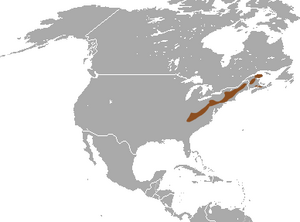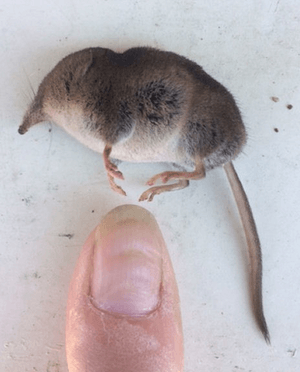Long-tailed shrew facts for kids
The long-tailed shrew or rock shrew (Sorex dispar) is a tiny mammal found in Atlantic Canada and the Northeastern United States. It's known for its long tail and its home in rocky, mountainous areas. This shrew is slate gray with a pointed nose and lighter fur on its belly. It loves to eat insects and spiders. Bigger animals like hawks, owls, and snakes sometimes hunt them.
Quick facts for kids Long-tailed shrew |
|
|---|---|
| Conservation status | |
| Scientific classification | |
| Genus: |
Sorex
|
| Species: |
dispar
|
 |
|
| Long-tailed shrew range | |
| Synonyms | |
|
Sorex gaspensis (Anthony & Goodwin, 1924) |
|
Contents
- What Does a Long-Tailed Shrew Look Like?
- Where Do Long-Tailed Shrews Live?
- What Kind of Home Does a Long-Tailed Shrew Prefer?
- How Do Long-Tailed Shrews Behave?
- What Do Long-Tailed Shrews Eat?
- Long-Tailed Shrew Reproduction and Life Cycle
- How Are Long-Tailed Shrews Protected?
- Similar Species: The Gaspé Shrew
What Does a Long-Tailed Shrew Look Like?
The long-tailed shrew is a small, thin animal. It's usually black or slate-gray. Its most notable feature is its long tail. An adult shrew is about 12 centimeters (about 4.7 inches) long, including its tail. Its body alone is usually between 4.8 and 7.9 centimeters (about 1.9 to 3.1 inches).
Tail and Whiskers
The tail is very long, often 80% to 90% of its body length. It's covered in fur that has two faint colors. Older shrews might lose some hair from their tails. This shrew also has a long, thin snout with whiskers that can be up to 2.3 centimeters (almost an inch) long.
Fur Color
In summer, the long-tailed shrew's fur is slate gray. The fur on its belly is lighter than the fur on its back.
Where Do Long-Tailed Shrews Live?
The long-tailed shrew lives in a specific part of North America. You can find them in the Appalachian Mountains. Their range stretches from Canada, including Nova Scotia and New Brunswick, south through the mountains to North Carolina. Some small groups are also found in Tennessee.
Specific Locations
In New York, they live in the Adirondacks and Catskills. There's also a small area in Pennsylvania where they live. In Massachusetts, you can only find them in Berkshire County.
What Kind of Home Does a Long-Tailed Shrew Prefer?
Long-tailed shrews like two main types of places to live. They often live near mountain streams. They also like to be under and among rocks. This is why they are sometimes called "rock shrews."
Rocky and Forested Areas
These shrews prefer mountainous areas with forests. These forests can have either deciduous trees (trees that lose their leaves) or evergreen trees (trees that stay green all year). They especially like rocky, damp spots. These areas often have many deep cracks and spaces in the rocks. These spaces can be covered by fallen leaves and tree roots, making perfect hiding spots. Rocks are a very important part of their home.
How Do Long-Tailed Shrews Behave?
The long-tailed shrew uses its long tail to help it balance. This is very useful when it's climbing over rocks and boulders. These shrews spend most of their time hidden. They are often underground or inside the many cracks and crevices found in their rocky homes. They stay active all year long, even in winter.
What Do Long-Tailed Shrews Eat?
The long-tailed shrew has a very narrow skull and large front teeth. These features help it find and pull out its food. They eat insects, spiders, worms, and centipedes. They are experts at getting these small creatures out of the tight spaces in rocks.
Long-Tailed Shrew Reproduction and Life Cycle
Long-tailed shrews have their babies in the spring and summer. Their breeding season can last from late April to August. A female shrew usually has one or two groups of babies, called litters, between May and August. Each litter typically has two to five young shrews. Because shrews have a short lifespan, they grow up very quickly. They can have their own babies in less than a year after they are born.
How Are Long-Tailed Shrews Protected?
Overall, the long-tailed shrew is not facing major threats across its entire range. However, there is one concern: they can accidentally eat pesticides. These chemicals get into the invertebrates (like insects and spiders) that the shrews eat.
Conservation Efforts
Most long-tailed shrews live in protected areas. These include public lands, national forests, and parks. To help keep them safe, it's important to prevent large-scale damage to their homes. It's also crucial to protect them as much as possible from pesticide pollution.
Similar Species: The Gaspé Shrew
For a while, scientists thought that the long-tailed shrews living in the northernmost areas were a different species. They called them the Gaspé shrew (S. gaspensis). These were found in the Gaspé Peninsula and Cape Breton Island.
New Discoveries
However, a study in 2004 showed that these two shrews were actually the same species. The long-tailed shrew just gets a bit smaller at the northern edge of its range. When they were thought to be separate, both the Gaspé and long-tailed shrews lived in similar places. Now, it's generally accepted that they are the same species. The name S. gaspensis is now considered an older, less accurate name for the long-tailed shrew.



